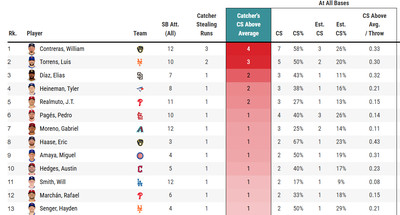
As compared to the past
When one thinks of catchers, catcher defense is usually the most important factor when deciding how good that catcher is. It’s sometimes been accepted wisdom that the defense of a catcher is priority to how he handles a bat. Having a catcher that is good at both? Utopia.
When the Phillies sent Garrett Stubbs to Lehigh Valley to begin this season, it was mostly because they knew that Rafael Marchan was going to be plucked by another club. Out of minor league options, Marchan was prime bait to be grabbed by something of a rebuilding club to be a catcher who was good behind the plate, helping starting pitchers with their game while at the same time giving a smidgen of offense. Instead, he’s with the Phillies and, along with J.T. Realmuto, have given the Phillies maybe the best defensive catching tandem in the game.
If you don’t believe me, look at the numbers. First, the throwing portion:

Basing it off of the throwing portion of the catcher’s defensive game, the Phillies have two catcher on which teams should not be running much. Having two catchers that can throw like this is beneficial in this age of stealing. Teams are running much, much more now that the rules have changed into order to make the chance more appealing. They’re doing so with a greater success rate, which is continuing to increase and encourage more attempts at baserunning thievery.
When Realmuto and/or Marchan both do throw, visually, it’s a thing of beauty.
Always possessing a strong arm, Realmuto does not seem to be losing any steam in that direction. His average throwing velocity is at 84.9 miles per hour, just a few ticks below last season. His pop time (1.84 sec) is still the best in the game. While there was concern that some of the advanced catcher metrics were starting to fall with him, this season, at least this early going, have seen a bounceback of sorts.
With Marchan, the throws he has had have been even more impressive.
And if you think Realmuto’s numbers throwing are impressive, Marchan’s throwing velocity (88.4 mph) would be second in baseball for all catchers with at least one steal attempt of second. His pop time (1.86 sec) is right behind Realmuto as one of the top ones in the game today.
However, there are other aspects of the game for a catcher. For the time being, the robot overlords are not behind the plate calling each pitch, meaning the umpire that is there can be fooled. Pitch presentation, or framing, is still a skill that some catchers excel at while others still struggle with the ability. The thing is, the difference between the best in the game right now and the worst in the game right now is two runs. The top in the game are worth, at least according to Baseball Savant, one run on the positive side of the ledger while the worst are one run on the negative.
Realmuto and Marchan? Squarely in the middle. Again, too early to make too many judgement calls, but if we wanted to inject a bit of subjective thought – that feels about right. Neither have really shown a crazy ability to steal strikes for their pitcher, but neither feel like they’re a detriment either.
Of course, there has to be bad news to all of this defensive goodness and with the Phillies, they can’t “block” out the bad too (lol).
Marchan and Realmuto are two of the worst blocking catchers in the game right now. Why that is, we don’t know. There could be any number of reasons. Conspiracy theorists will point to them being catchers who have one leg out in their setup, but I’m not sure there is evidence yet that that makes a catcher worse at blocking. Plus, the above linked leaderboard is block above average. How much that actually leads to wins and losses is minimal since, again, the difference between the best and worst by blocking runs is two runs. That’s hardly anything.
Still, we can pretty well say that both Marchan and Realmuto are two good defensive catchers. There is still the ultimate way of measuring how good a defensive catcher one can be: game calling. That’s what catchers are most responsible for since there are roughly 200 examples each game that can be looked at, but as Fangraphs says:
Finally, game management (or game calling) remains the black box of catcher defense. No one has cracked this code. Catchers play a huge role in determining which pitches to throw and how a pitcher navigates a given lineup. Honestly, there is no public research that provides much insight into game calling. By all accounts, it should matter, we just don’t have any idea how to measure it.
How much weight would be assigned to the catcher is likely the issue since most of the pitch execution has to fall on the pitcher, but that’s a bridge to cross another day.
What the Phillies do have is a good defensive option any day one of the two catchers is behind the plate. It’s a pretty far cry from the past few seasons.
Now about that catcher offense….